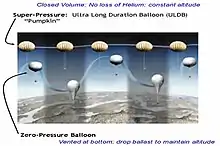Zero-pressure balloons
A zero-pressure balloon (ZP) is a style of aerostatic balloon that is unsealed at its base, creating a mechanism by which lifting gas can vent out the bottom of the balloon when the balloon becomes full, allowing the balloon to float at stable altitudes. During the day the gas heats up in the sun, and at night the gas cools causing them to descend. This limits the flight time of this type of balloon.[1][2]

Flight profile of super-pressure balloons versus zero-pressure balloons
The Columbia Scientific Balloon Facility has flown more than 1,700 scientific balloons over 40 years and currently launches between 10 and 15 flights of this type of balloon per year.[1]
See also
References
- "NASA Scientific Balloons Take to the Sky in New Mexico". NASA. NASA. Retrieved October 1, 2023.
- "Scientific Balloons". NASA.gov. NASA. 13 July 2015. Retrieved 14 July 2020.
This article is issued from Wikipedia. The text is licensed under Creative Commons - Attribution - Sharealike. Additional terms may apply for the media files.